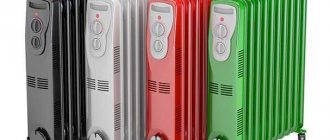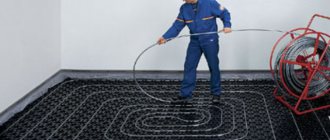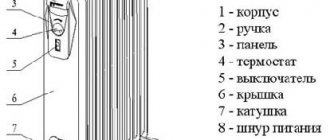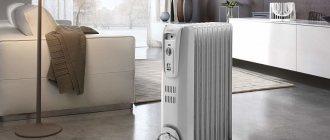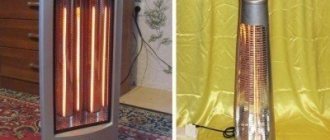Installing an oil radiator for heating in a country house or garage is now commonplace and necessary. After all, despite all the delights of scientific and technological progress, interruptions in heating still occur. You can assemble such a unit yourself or purchase a factory model, but in any case, sooner or later all owners are faced with the need to repair these products. We will talk about possible breakdowns and intricacies of assembly now.
The photo shows a voluminous homemade unit.
Oil heaters (heating radiators)

Externally, an oil-type radiator is similar to a conventional sectional battery that hangs under the windows in apartments and houses. The only difference is the operating principle and the energy carrier - the portable radiator operates from the electrical network, and not from the central heat supply from the boiler room.
Design and principle of operation - how does it work?
The difference between an oil radiator and analogue stationary heating devices is that it operates from the mains. If in conventional batteries there is water inside the sections, then here there is mineral oil. When plugged into the network, such oil boils, heating the walls of the device, which, in turn, heat the room with warm air.
The operation of the equipment is ensured by:
- Thermostat.
- heating element.
- Control panel with plastic knobs and incandescent thermometer.
- A network cable that provides power supply.
The body of the product is made of metal, which is coated on the outside with a special anti-corrosion and anti-shock powder coating. It is this composition that helps to avoid surface damage to the plates with further deformation.
Each section of an oil-type radiator has a hermetic, dense base that does not allow the seams to separate when the oil heats up.
Advantages and disadvantages

Depending on the manufacturer, such a device has certain design features: an autonomous controlled thermostat or a touch control panel. But, in any case, the heating element has a number of advantageous characteristics, including:
- silent operation, no extraneous sounds occur when the oil is heated;
- high level of heat transfer - efficiency;
- long service life without the need for repairs - a guarantee of 5 years or more;
- does not emit chemical or other unpleasant odors when heated;
- Easily transported from room to room thanks to the available wheels;
- does not contribute to dry air.
Among the disadvantages, it is important to note such features as the long period from heating the heating element to the supply of heat to the space, as well as the large weight of the product. However, such disadvantages are relative - weight is not a problem, since there are wheels, and after heating, the temperature lasts longer than when using other heating devices.
Devices with a built-in fan heat the room faster; literally within 1-2 minutes after switching on, the radiator heats the room.
Is it dangerous? Safety precautions
Existing warnings regarding the toxicity of the oil in the radiator are unfounded.
Modern devices have double or triple protection, which, even with a direct impact, does not violate the integrity of the coating.
Hot oil is indeed under pressure inside and is a flammable component. But the degree of protection of the heater is so high that with proper operation for many years no negative aspects will be noted.
Each oil-type radiator has a glow sensor that is activated when heated to 60 degrees. Above this temperature, heating does not occur - the heating element turns off.
DIY 12 volt heater (24 photos)
How to make a 12 volt heater with your own hands: detailed photo instructions.
This simple heater works on the principle of a heat gun; a fan drives air onto a heated coil, resulting in a flow of warm air. The device operates from a 12 V power source; it can be connected to the car’s on-board power supply or to a 12 V battery.
To make a homemade product you will need materials:
The entire process of making a homemade heater is shown in these photos.
As a heating element, the author used a piece of nichrome wire 1.8 mm thick, 61 cm long. The wire needs to be wound in the form of a spiral; here the author wound the wire on a 30 cc medical syringe.

Now you need to make a base on which the spiral will rest; it is made of plaster. The gypsum is mixed with water until it reaches a liquid consistency; we collect the liquid gypsum into a syringe.
Classification and main characteristics
There are many oil-type radiators, which differ in the number or presence of additional options - built-in mechanisms, fans or place of operation.
Wall mounted
Models that can be attached to a vertical surface are called wall-mounted. They tend to be flatter and have non-protruding sections that do not interfere with the bracket's ability to catch on the hanging hooks. Often such modifications are universal - they have a place for screwing on wheels, which allows you to install them on the floor in the right place.
Floor-standing

The heat transfer of such a floor-mounted device is the highest. There is a separate subtype of floor models - baseboard heaters. They are installed in the corner of the wall and floor in place of the baseboard. They have a long and narrow shape.
Tabletop
Modifications that can be placed on a table are small in size and the same weight. They are designed to provide additional heating to a small room. Also used in the form of heating a children's room or crib.
The number of sections for tabletop types is no more than 5; the height of such sections is half that of floor ones.
For cots
Radiators designed for heating children's rooms differ, in most cases, in their appearance and mobility.
These can be either wall or tabletop modifications with bright colors. A significant advantage of using such a heating element is that the air does not dry out, and the humidity during battery operation is at least 60%, which is important for children who are often ill.
Children who often suffer from acute respiratory viral infections or chronic lung diseases - bronchitis, laryngitis, tracheitis - need constant air humidification. Fans that operate on the principle of a hair dryer cannot be used to heat a room - they heat up and move air around the room.
Making a car heater with your own hands
We continue to talk about homemade electrical appliances, and our new master class touched on electric heaters - very useful things in everyday life that have saved many people in the winter more than once.
In fact, assembling a simple heating element at home is not difficult even for an inexperienced electrician. You just need to have some available tools available to everyone, and a diagram according to which the assembly should be carried out.
Below are some interesting ideas with photo and video examples that you can use to make your own heater for your home, garage, and even your car!
Tips and tricks for choosing
Radiators are produced with different power, which, among other things, depends on the number of sections: the more there are, the larger the heating area. The disadvantage of increasing the number of sections is the need to provide more space, which is difficult in small rooms. Although, such parameters for assessing characteristics are individual and this does not affect the mobility of equipment. In general, when purchasing an oil-type heater, pay attention to several features.
Continuous operation of the oil battery – 3 days.
Electricity consumption and the most energy efficient range
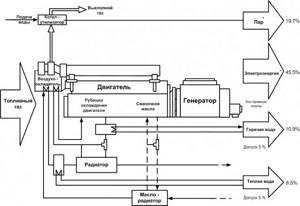
The convenience of oil radiators is obvious, but some buyers are confused by the energy consumption of such an installation - how much does the battery use per day? The power of the device is selected according to the size of the heated room. On average, heating 10 sq/m of space requires 1 kW of energy, if it is a living space with ceilings of 2.75-3 m. If the ceilings are higher, the calculation is carried out:
- The area of the room is calculated - the length is multiplied by the width.
- The volume of the room is determined by multiplying the area by the height.
- Divide the resulting number by 25 (because 25 m3 produces 1 kW).
- The result obtained is the heater power we need. If the quantity is very large, then you need to buy several radiators, which in total will provide the required energy
So, according to the above calculations, it turns out that for a room of 20 square meters. m, a 1.5 kW heater is suitable.
Dimensions and appearance (flat, small)
The height of one section is from 580 to 700 mm, width is 362-650 mm. The depth of the section to the central part is 90-290 mm. The number of such sections is 5-12, the most popular models with 9 or 11. They are flat, wide or narrow in shape. The smallest ones are plinth ones, their length is up to 1.5 meters, diameter is 50-90 mm.
The surface temperature differs from the maximum heating of the oil itself. So, if the oil is heated to a temperature of 60 degrees, then the surface of the sections heats up to 95°C.
Control
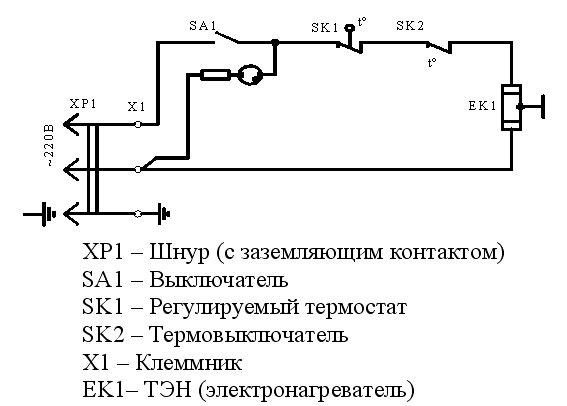
The control unit for oil convectors is located on the side of its end part. As a rule, this is a plastic panel with switches that control:
- operating modes;
- light indicators;
- humidifiers;
- shutdown sensors when the device overheats;
- duration of operation of the TEN;
- air heating temperature;
- Energy consumption;
- fan operation;
- duration of rest mode during continuous work.
Some modern models have LCD monitors with touch controls even from a distance.
Manufacturer and price - how to choose?
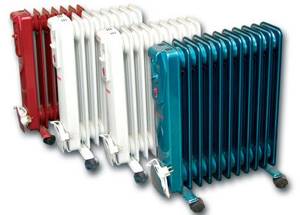
The range of products for heating autonomous rooms is large. Almost any household store has several manufacturers, but according to customer ratings, the most frequently purchased are:
- Vitesse VS-877.
- General Climate.
- Timberk.
- DeLonghi.
- Bimtek.
The price of radiators, depending on the number of sections and the manufacturer (domestic or imported), starts from 3 thousand rubles to 30 (for domestic needs, other amounts for industry).
For industrial purposes or for home: household or industrial
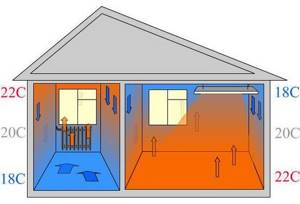
If for domestic needs there are a large number of offers at different prices, then for industry there is a separate line of products that differ in power, size and, accordingly, price. The maximum number of sections of one oil radiator is 14. For industrial premises, it is important not only their required number, but also their correct location. Thus, suspended models heat the air faster, and the power of the device must be at least 2.5 kW.
How to make a 12 volt heater with your own hands
Making your own heater is easy.
What kind of heater should you make for your home?
Almost all types of heaters can be made at home. The exception is the inverter, because its design is very complex. Most modern devices create heat with virtually 100% efficiency. All of them have an electric heating element, the main part of which is nichrome wire.
The simplest homemade heater for a garage and a house made from this wire has the following structure:
Such a heater is unsafe, because in addition to the fact that the wire can heat up to 1,000 °C, it also remains open. Contact with it threatens not only burns, but also electric shock. Also, such a device can burn down part of the house.
Many craftsmen note that devices with nichrome wire should not be made at all. It is possible to design a heater that is both safer and more efficient. This is the infrared option.
Unlike most heating devices, it does not heat the air around it, but gives off heat to surrounding objects. It only heats what is needed.
Autonomous heating device
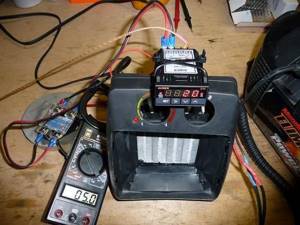
This heater is designed for 12 volt current. Thanks to this, it can be connected to a battery. It can be used in rooms where there is no heating and where renovations are being carried out, as well as in the garage or any room in the house. Its power is not enough to heat the entire room. It does not create infrared rays. It only heats the air.
To make it you need to take:
A 12 volt device is made as follows:
The 12 volt heater is ready. Now all you have to do is connect it to the battery and wait 10 minutes. During this time, the homemade garage heater will warm up. When using a device with an operating voltage of 12 volts, you need to monitor the battery voltage. It should not fall below 10 volts. Otherwise, the current source cannot be restored.
The heating device made will work until the lamp fails. Its functionality can be restored by replacing the lamp. You can even put a halogen lamp in its place.
Oil device
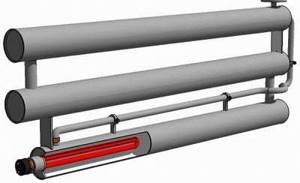
A homemade oil heater is a fairly functional and safe device. It has high efficiency and is therefore suitable for those rooms where various household appliances are repaired.
Its design consists of a sealed housing, inside of which there is oil and heating elements.
Before making a heater with your own hands, you need to prepare the following materials:
Ceramic heaters for home
You will have to work with a drill and a welding machine.
Installation
Installation of the heater does not require special skills and knowledge. If it is a hanging model, it is mounted on brackets that are pre-installed at the required distance from each other. If the model is mobile on wheels, then all that is needed for installation is to determine the safest place near the outlet. It is worth considering that there should be no obstacles in the heater’s path - curtains, sofas or chests of drawers. It is best to install it in the central part of the room in the first 2-3 hours of operation. After the space has warmed up, it is moved to a more comfortable distance - near a wall or fireplace.
Why install a radiator on engine oil?
A very simple answer - to cool the lubricant ! But why cool it is a more complicated question.

Let's start with the fact that in 90% of cases, as I wrote above, the car has enough coolant that circulates through the main radiator (the one in front, under the decorative grille) and the heater radiator (which is in the cabin). Heat dissipation, say, on an ordinary foreign car (or a class B - C car) is sufficient.
BUT! There are difficult cases when this is not enough, and then they start connecting oil cooling. This happens mainly on loaded engines.
Some believe that “oil injectors” and an oil cooling radiator work on the same principle, that is, they cool the engine with oil. BUT this is extremely wrong!
Oil injectors work mainly to cool the piston, that is, they take additional heat from the engine so that it does not lose its geometry, I have a useful video about them, I recommend everyone watch it.
But the cooling radiator takes the temperature away from the lubricant so that it does not lose its properties ahead of time.
Oil

It retains its properties at temperatures down to -45 degrees. Produced from oil by distillation, it has slightly different characteristics. For oil batteries, mineral oil is used, which is similar to transformer oil. Filling the radiator with synthetic gear oil will contribute to its noisy operation - it will begin to make noise and rattle due to the fact that the viscosity is lower and the intensity of convective flows is higher.
It is impossible to use a mixture of oils of different origins for radiators due to the interaction of the different additives present, which after heating it is not known how they will behave. The composition may either curdle or precipitate or thicken. Adding the missing oil is done with identical material available in the device.
Conclusion
An engine oil cooling radiator is not included in the standard equipment of all cars, but it copes so effectively with the task of controlling the oil temperature and protecting the engine that many car enthusiasts decide to install this device on their vehicles. The radiator cannot be called a durable car part - it has little mechanical strength, and the connecting elements of the oil system tend to gradually age and depressurize. An engine oil leak should never be ignored, and in systems with a special cooler it can also be observed in the radiator. If the car requires replacement of the oil cooler, we recommend purchasing spare parts from well-known European manufacturers. Although they will not be cheap, they will guarantee the efficiency and durability of the engine oil cooling system.
source
Which is better: oil or convector
When considering the advantages of convectors or oil radiators, it is worth paying attention to such features as power consumption, dimensions and additional functions. If the heater is needed for regular use, then it is better to choose oil models. For periodic use in insufficiently warm rooms, you can buy convectors with a top supply of warm air.
Heating an apartment or house is a task that arises quite often even with centralized heating. This is due to insufficiently warm stationary radiators or poor location of the apartment, damp weather before the heating season or a desire to better warm up the child’s room. In any case, oil batteries will help ensure the desired temperature in residential areas.
Electric fan heater for a car. Do it yourself or buy ready-made? — DRIVE2
Making an electric fan heater with your own hands.
The first thought that arose when wanting to own a fan heater was that it was a trivial matter and you could probably assemble it yourself. There are formulas for calculating the heat released on the heater coil.
First we need to decide on the power, it will be about 200 W, that is, the current strength is 16 A.
In addition, using a caliper you need to measure the diameter of the wire that will be used for the heating element; it was taken from an old electric stove, with a diameter of 0.45 mm.
Calculation of the length of nichrome wire for use in an electric car fan heater
(P=I*U=I*I*R)** that is, in our case we get 200=10*10*R, the thread resistance should be 2 Ohms. (R=(1.27*q*l)/(d*d))** resistivity of nichrome q=1.1 that is 2=1.397*l/0.2025 l=2/6.89=0.29 m. Using these formulas** You can make calculations to calculate a fan heater of any power and for any diameter of nichrome wire.
Fans used for electric heater in a car.
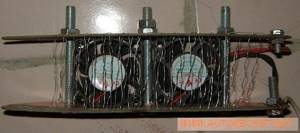
If everything is clear about the wire, then selecting fans is practically an empirical task, solved only with the help of your intuition and experiment.
The fan must, firstly, have a 12 V power supply; computer fans are found with this supply voltage.
In this case, the output air flow must cool the fan heater filaments, so that they do not burn out and so that the air still blows warm.

